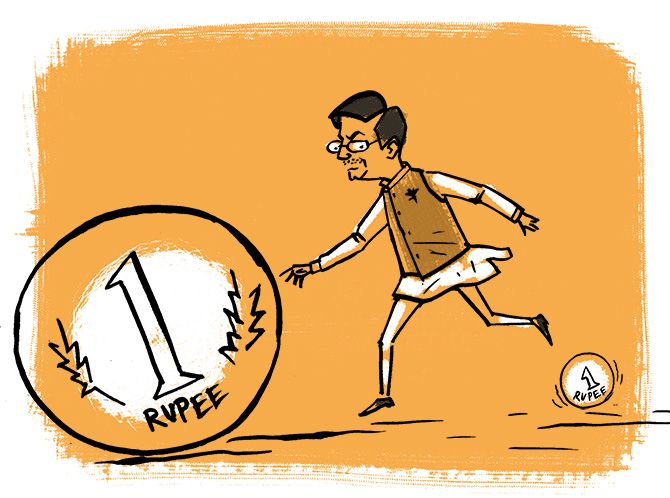 | « Back to article | Print this article |
The point to note is that since the new rebate is up to a taxable income of Rs 5 lakh, if anyone earns even little more (say, even Rs 100 more) than this amount, he would have to pay all the taxes, according to the existing slabs.
Illustration: Dominic Xavier/Rediff.com.

Finance Minister Piyush Goel has chosen to put extra money in the pockets of the middle class in an election year. In addition, he has tried to make life more convenient for deposit holders.
Tax benefit extended
Goyal has made changes to Section 87A of the Income Tax Act, which deals with rebates. The interim Budget proposes to increase the limit of rebate from a taxable income of Rs 3.5 lakh to Rs 5 lakh. This means that people earning up to Rs 6.5 lakh (tax benefits of Rs 1.5 lakh under Section 80C) or more, depending on the exemptions such as medical insurance and others, will benefit from this move.
In short, this is how the tax benefit will work. The basic exemption limit of Rs 2.5 lakh applies to everyone. Earlier, if your taxable income was up to Rs 3.5 lakh, you got a tax rebate of Rs 2,500. Now, this threshold has been hiked further to Rs 5 lakh.
The tax liability for someone earning Rs 5 lakh is Rs 12,500: Rs 5 lakh less the basic exemption of Rs 2.5 lakh means a taxable income of Rs 2.5 lakh. When this amount is taxed at 5 per cent, the tax liability is Rs 12,500. “Now, if your total taxable income is Rs 5 lakh or less, you do not have to pay any tax,” says Archit Gupta, founder and CEO, ClearTax.
The point to note here is that since this is a rebate up to a taxable income of Rs 5 lakh, if anyone earns even little more (say, even Rs 100 more) than this amount, he would have to pay all the taxes, according to the existing slabs.
“Only individual taxpayers with taxable income not exceeding Rs 5 lakh no longer need to pay any tax. Others will still need to pay tax on the 5 per cent tax slab, as the benefit has been proposed by raising Section 87A rebate limit to Rs 12,500,” said Kuldip Kumar, partner and leader personal tax, PwC India.
Standard deduction limit raised
The FM has also raised the standard deduction from Rs 40,000 to Rs 50,000. Standard deduction was introduced in the 2018 Budget. The government did away with travel and medical reimbursement and instead introduced a standard deduction of Rs 40,000.
“Both people who have salaried income and those who have pension income are entitled to standard deduction,” says Gupta.
With this change, those in the 30 per cent tax bracket will get a benefit of Rs 3,000, those in the 20 per cent tax bracket will get an additional benefit of Rs 2000, and so on.
TDS limit on interest income hiked
The tax deductible at source (TDS) threshold on interest income from bank, co-operative society and post office deposits (other than interest on securities) has been raised.
This will not mean any tax benefit, but it will result in greater convenience.
Earlier, banks would start deducting TDS if your interest income in a year exceeded Rs 10,000. Now, they will do so only if it exceeds Rs 40,000.
“This change will benefit people who do not have any taxable income but have interest income in excess of Rs 10,000, say, a housewife,” says Deepesh Raghaw, founder, PersonalFinancePlan.in, a Securities and Exchange Board of India-registered investment advisor.
Earlier, people had to fill form 15H (for senior citizens) and Form 15G (for others) declaring that they did not have any taxable income and, hence, the bank should not deduct TDS.
When TDS has been deducted, the depositor has to file income tax return, and it takes a few months for the tax department to return the money. This change will mean fewer hassles for a lot of people.